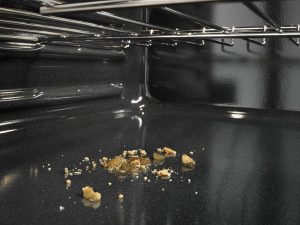The Self Clean Basics:
Many convection ovens have a self-clean feature, but it doesn’t involve soap and a scrubbing brush. Instead with this setting, the interior temperature rises to approximately 800 degrees. This high heat will help to incinerate any food debris or gunk that has adhered to the oven walls. Once the oven has cooled after the self-clean cycle, and it will cool slowly, you can simply wipe out any residue.
Newer steam ovens may also feature a self-clean function. This uses steam to blast the inside of the oven and eliminate any gunk. This typically uses less energy as the extremely high temperatures are not necessary.
With either type of self-clean feature, it is easier and less time consuming to keep your oven clean. You can set the oven to self-clean and then go about other tasks around your home, coming back later to run a cloth over the inside of the oven.
The Benefits of the Self Clean Feature:
Before we explore the potential dangers of the self-clean feature, it is important to highlight the benefits of this function. These include:
- Timesaving: Rather than needing to take the time to hand wash the inside of your oven, you can set the oven to self-clean and then you’ll only need a minute or two to wipe it down afterward.
- Ability to Multitask: Since you don’t need to supervise the self-clean cycle, you don’t need to be stuck in the kitchen. You can clean the oven and tackle other projects around your home.
- Less Messy: If you’ve ever cleaned an oven by hand, you’ll know that it is a messy job. With cleaning liquids and sprays, multiple cloths and gloves, you can end up feeling extremely grimy when you’re done. Since the self-clean cycle is automated, the mess is contained within the oven.
- No Toxic Chemicals: This follows on from the previous point, but oven cleaning products tend to contain very harsh chemicals that are not only dangerous to inhale, but can burn the skin. Therefore, a self-clean cycle is far more natural and environmentally friendly.
- More Efficient Cleaning: Finally, since all the food debris and grime is blasted off the oven walls by high heat or steam, it provides a thorough cleaning of every inch inside the oven, for a more efficient clean.
The Potential Dangers of the Self Clean Feature:
Unfortunately, there are a few potential risks of using the self-clean feature on your oven. These include:
- Overworking the Appliance: It takes a great deal of power for a standard oven to generate the high temperatures needed for the self-clean cycle. This has the potential to overwork the appliance, particularly if you have an older model that is nearing the end of its lifespan.
- Fumes: While you’re not using harsh chemicals, the self-clean feature can still produce some fairly noxious odors as the food debris and gunk is burned away. So, if you don’t ventilate the space properly, you could end up causing a nasty smell throughout your home.
- Potential for Fire: Finally, if there are chunks of grease or large pieces of food inside your oven, there is the potential that it may ignite. While a fire inside a sealed oven is not necessarily dangerous, it could spread to the control panel or blow a fuse.
If your oven is struggling to self-clean, it may be time to consider an upgrade. You can explore your options with our online oven and range collection or you can speak to one of our home appliance repair specialists for expert help and guidance.
